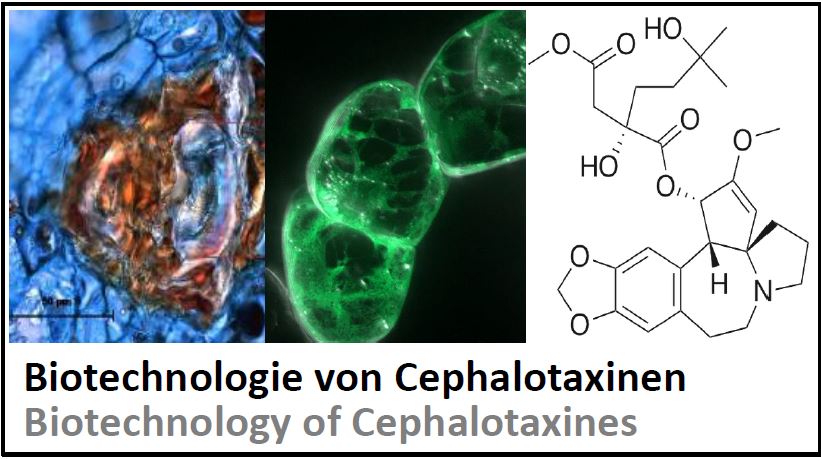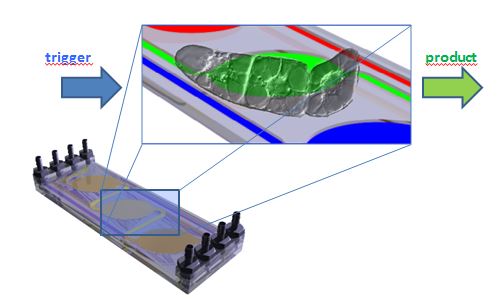 Plant Cell Biology 2022
Plant Cell Biology 2022
The Hainan Head Yew (Cephalotaxus hainanensis) belongs to the rarest trees on our planet. Only a few hundred individuals are left and have to be guarded, because people come at night to steal the bark, which is traded with eight times the price of gold. The reason are specific alkaloids, the harringtonines that are the most potent anti-leucemia compounds known. Would plant cell fermentation be an alternative? The entire transcriptome could be constructed in 2014 and based on this the pathway for harringtonine biosynthesis is currently constructed in a cooperation with the group of Dr. Fei Qiao in the Chinese Academy for Tropical Agriculture, Hainan. The early pathway leading to the scaffold of the phenylisoquinoline alkaloids has been constructed and the genes involved have been cloned. M. Sci. Nasim Reshadinejad has generated tobacco lines overexpressing those, and the project deals with the phenotypisation of these lines. In the focus are regulatory aspects of the genes that seem to be controlled by the abundance of the substrate, but also attempts to reconstruct the situation in the plant by playing "metabolic LEGO", combining different transgenic cell types to test, whether this yields the compounds predicted by the one or the other hypothesis.
Microfluidic Bioreactor
Plants produce around one million specific secondary metabolites. Many of those function to steer the interaction with other organisms and therefore many of those are pharmaceutically active. Technical synthesis of these valuable and costly compounds is often challenging or even impossible, such that they have to be extracted and purified from their natural source. The underlying metabolic pathways are complex and usually require interaction of different cell types till the compound is stored in specialised, often individual excretory cells. This renders extraction cumbersome and inefficient. Moreover, many of these plants are rare and endangered. For instance, the Pacific Yew was brought to the verge of extinction by the discovery that Theo compound taxol found in its bark can cure cancers. Biotechnological approaches would provide more sustainable alternatives.
Molecular Farming – Potential and Limitations.
Especially in situations, where small amounts of a costly product have to be produced, Green Molecular Farming turns out to excel other systems such as transgenic animals or microorganisms. Since the system of production is closed, the controversial issue of GMO spread can be circumvented. The focus, at present, is still on protein based compounds. Synthesis of secondary metabolites still plays only a marginal role. This is not caused by a lack of interest – the synthesis of the anticancer compound vinblastine in cell lines of Catharanthus roseus has been pursued over half a century by now with only modest outcome. A limitation for Molecular Farming has been the forementioned compartmentalisation of secondary metabolism to different cell types, what is difficult tob e mimicked in a bioreactor. The production of valuable plant secondary compounds requires that cell types providing different metabolic steps are coupled by a flux.
Our new approach – modular microfluidics.
Our idea starts exactly from here. Basically, we want to simulate a plant tissue technically. This is not achieved by conventional fermenters, but by a microfluidic system that provides a metabolic flux between different cell types that carry individual metabolic steps. The product is then measured in the flowthrough. By the modular organisation allows for different combinations to produced different compounds (even derivatives that would not naturally occur in the plant). A metabolic module consists of cells, where by genetic engineering specific metabolic key enzymes are overexpressed. As proof-of-principle we investigate the flavonoid-/stilbene pathway (synthesis of the potent antitumour compound quercetine-aglycon) of grapevine, the alkaloid pathway of tobacco (synthesis of the anti-Alzheimer compound nornicotine), and the alkaloid pathway of the Indian Wintercherry Withania (synthesis of withanolides with high potential against Parkinson).
Where we are
In cooperation with the group of the lab of Dr. Guber, Institute for Mikrostructure Technology (KIT-CN) we developed over several years a microfluidic biofermenter that is now submitted for patenting. This system allows to cultivate the plant model tobacco BY-2 over longer periods. The system was optimised to maintain biological functionality of plant cells and to harvest in the flowthrough different secondary metabolites.

